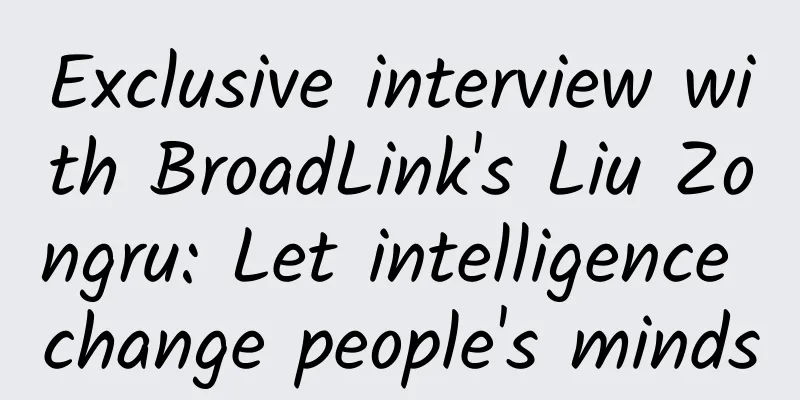Exclusive interview with BroadLink's Liu Zongru: Let intelligence change people's minds

|
As the current wave of smart hardware innovation is sweeping the hardware and Internet fields, various incubators and distribution platforms focusing on smart hardware have sprung up like mushrooms after a rain. On January 14 this year, Google announced on Monday that it had reached an acquisition agreement with Nest Labs, a smart home company founded by Tony Fadell, the "father of iPod." The former will acquire all the assets of the latter for $3.2 billion in cash. The deal is the second largest acquisition in Google's history, second only to the $12.5 billion acquisition of Motorola Mobility in 2012. Like the Motorola deal, which marked Google's first foray into hardware, the Nest acquisition gives Google a springboard into an important new market. Various giants are laying out their smart hardware, and a battle for smart devices has begun. Early concept In fact, the concept of smart home was proposed as early as 1994, but it was still in the conceptual stage at that time. It was not until 2011 that the entire smart home market came to the fore. Liu Zongru, CEO of Hangzhou Gubei Electronics and BroadLink, also mentioned in an interview: In 2012, we provided a complete set of solutions for solar water heater manufacturers across the country, from APP development to cloud services. They also did it, but only made 500 to 1,000 and put them in their exhibition hall for demo. At that time, they thought that the timing might not be right and there was no obvious market demand. " Until this year, the smart hardware market seemed to blossom overnight, from wearable devices such as smart bracelets and smart watches to smart water cups and smart lighters. It seems that if you don’t mention intelligence, you would be embarrassed to say that you are in the hardware industry. The same is true for the smart home market. Liu Zongru said: "We have also started to develop some single products to guide the market, including sockets, remote-controlled lights and a series of small appliances. We found that the market is very prosperous." At this time, home appliance manufacturers also actively demanded intelligence. After all, no one wants to be the next Nokia. Liu Zongru admitted: In the past, we were the ones who went to find customers, but now customers come to us. In fact, the popularity of smart hardware is not groundless. Liu Zongru said: "In the past, ordinary people did not have the opportunity to experience smart homes. Through these small things, they can experience smart homes and find that the demand is there." Smart socket that can achieve great results with just a little effort In the early days of smart homes, there were many devices that could be made smart, so why did BroadLink choose sockets? Liu Zongru explained: "First of all, the socket can enter the market at a relatively low cost. For users, the learning cost is the lowest. It is very simple to get started, and the control is also simple, such as power off and timing. Although the learning cost of the smart remote control launched later is relatively high, we have been improving the technology to reduce the learning cost of users. Therefore, the socket is the fastest to use, which is also the reason why we chose the socket." Compared with high-end devices that cost thousands of dollars, a small socket is more easily accepted. After all, not everyone is a geek. The concept of "home" is very important in smart homes. Home is not a paradise for geeks, but a place that needs to be warm, comfortable, and cost-controlled. In a sense, the understanding of "home" will largely determine the quality of a smart hardware. Sensors for all five senses When asked about the next smart hardware, Liu Zongru said: We made an environmental detector with several built-in sensors, including temperature and humidity, light, harmful gases, noise, etc. We made a demo and gave it to the market to educate the market that sensors can be linked. " Sensors in smart home systems are like human sense organs, sensing the outside world. However, a single sensor cannot play a good role. For example, we use temperature and humidity sensors to adjust the air conditioner, but we don’t know whether the window is open. If the window is open, it is useless. Therefore, sensors communicate with each other and know the overall situation. Whether it is human or machine, mistakes are inevitable. So when there is a problem with the sensor and we are unable to rush to the scene, the disaster may have already occurred. Liu Zongru also believes that "this situation will definitely occur in the early stage, but solving this problem requires the accumulation of technology and the mining of big data. For example, Nest's smoke sensor has also had problems. If a company wants to expand and deepen in this field, it must get rid of the form of a toy and become a truly reliable product that must rely on technology. De-toy There are countless types of smart hardware on the market, but they are like isolated toys. Smart hardware that is independent of each other cannot form a system, and cannot be truly intelligent. Liu Zongru told reporters that if the socket is connected to the Internet and can be remotely controlled, then it is a toy. Intelligence is divided into three stages. The first stage is the Internet of Things, which is the current stage. The second stage is the interconnection between devices, which can recommend scenarios for users and say goodbye to toys. The third stage is artificial intelligence. Baidu Brain or Google Brain will be within five years. Platformization If we want to de-toyize, we must make devices interconnected, which is what the current smart hardware market lacks the most. Many large Internet companies are laying out smart hardware platforms. Google also believes that the Internet of Things needs its own Web standards and has released Google Physical Web, which allows users to interact without downloading apps. Apple's iBeacon technology can also achieve an O2O closed loop by allocating intelligent resources to the client (smart device), beacon end and cloud end. Of course, all of this is open within a relatively closed system. Liu Zongru also said: "For users, how can they use it smoothly? They certainly don't want every product to be incompatible and need many apps to control it, so they need a platform. The real big platform still needs big companies to build it." Broadlink's positioning of the three-party link: one is the home appliance manufacturers, and making them smart is actually equivalent to the hands and feet of the home, that is, the execution end. The second is the sensor as the five senses of the human body. The third party is the big platforms such as Baidu, JD.com, and Apple. Real intelligence still requires big platforms to do data mining and realize artificial intelligence. Let intelligence change your mindset After talking about layout and intelligence, the real problem is how to get ordinary people to buy. Now, the main purchasing power of home appliances is women born in the 1960s and 1970s. People of this age generally have a concept: if something can be used, there is no need to buy a new one. This concept is also a major factor that restricts the smart home market. "It was definitely like this in the early days. People change from generation to generation. Those who are getting married now are those born after 1985. They will consider this when buying a new home. Moreover, this thing is really smart and the elderly will accept it. Take WeChat for example. How many elderly people use WeChat now? They didn't use it before, but now they use tablets to communicate with us on WeChat all day long. This change is much faster than before," said Liu Zongru. "I don't think that smart home appliances will explode all at once and everyone will switch to smart home appliances. It will take another 10 years for smart home appliances to enter thousands of households. But the intelligence of home appliances cannot be stopped. Just like the transition from feature phones to smartphones. Profit Model Someone previously proposed a bold idea, hoping that hardware can be free like broadband Internet, and rely on service fees to make profits. However, Liu Zongru has a different view. He believes that it is still very difficult for a hardware company to make hardware completely free. Unless the company is building a large platform for future data or services. However, the industry is still in an early stage of development, and it is still very difficult when chip prices are still very high. Moreover, most of the companies that are making smart hardware are start-ups, and they do not have strong funds like large companies to pad this matter. There must be a healthy operation to continue research and development. Even if the hardware is free, it still needs the subsequent service fees to make money. Without this premise, there is no talk of free hardware. For Entrepreneurs Smart hardware is so popular that many entrepreneurs want to enter the field of smart hardware. Liu Zongru also gave some suggestions. Compared with software, making hardware is very painful. Hardware is just a way of implementation. The software superimposed on the hardware will win in the end. Hardware also needs the support of software; including data mining, artificial intelligence, in fact, a lot needs to be done in software. In the early stage, when there is sufficient funds, you can make hardware. There is no problem. The hardware market is too large. Every product in each subdivided industry will have a good explosion point if it is smart. If you start your own business without strong funds, you still have to think about it. The pit of smart hardware is still relatively large and the investment is relatively large. It might be a good idea to make some software that provides value-added services for hardware, just like the big data mining and artificial intelligence mentioned earlier are still very promising. |
<<: 4G stimulates operators’ transformation towards the Internet
>>: Android 5.0: Root's super nightmare!
Recommend
New weapon against cancer! China Spallation Neutron Source: making the microscopic world “visible”
From "a piece of paper plan" to the cre...
NIO to release new ES6, targeting Tesla Model Y
Recently, some media revealed that NIO will relea...
Practical Tips | How to create an April Fools' Day event with 500,000 PVs in 3 days with 1,000 yuan!
The biggest phenomenon-level event on April Fools...
Jiang Xiaobai, the sad tea, read these 100 sad copywritings - forget it, you can't learn it
From "UCC Coffee" to "Sad Tea"...
Product Operation: 2 major ways to get started to accurately manage private domain traffic!
Ever since WeChat issued a notice to ban check-in...
International Rare Disease Day丨"Puppet Man" and "Porcelain Doll"...How much do you know?
Xianxian (pseudonym), who is two and a half years...
How to write copy that will wow users? Try these 3 methods
What exactly is “resonance”? Why do some articles...
The brain accounts for only 2% of body weight. How does it control body activities?
Human beings’ greatest curiosity is to explore th...
21 ways for advertisers to die!
As an advertiser There are always 30 days every m...
If food is one day past its expiration date, can it still be eaten?
In the past two years, near-expiry foods have sud...
What is the situation with mobile phone production capacity?
Looking at all the so-called domestic products in ...
How to start community operation and fission planning from scratch?
In order to seek breakthroughs under the epidemic...
Predictions on how to play Douyin Spring Festival Gala red envelopes
Since 2014, sending red envelopes on the Spring F...
[Girls' Emotions] Analyze 90% of emotional problems between the sexes and help you win the battle to defend your love
【Girls' Emotions】Analyzes 90% of emotional pr...
Introducing 5 data-driven and practical customer acquisition methods
Admittedly, in many cases, the acquisition of new...









